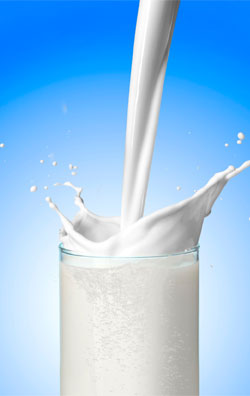
Milk is a source of nutrition for children and adults. It contains lactose, casein, minerals, lipids and even vitamins. Animal milk is being used commonly as food for its own younger ones as well as for humans. Even though it has a high nutrient value, it is not free from the attack of different types of bacteria.
Breast milk or human milk contains small amounts of Staphylococcus epidermidis, Streptococcus mitis, Staphylococcus aureus, etc. Some bacteria commonly seen in milk do not produce any visible changes in them. They are termed as inert bacteria. They include members of Achromobacter group. Certain proteolytic bacteria such as Bacillus cereus, Bacillus subtilis, Staphylococcus, Micrococcus and Proteus vulgaris are also seen.
Sometimes milk may be contaminated by Coliform bacteria which result in its ropiness. Certain Clostridium species like Clostridium perfringenes and Clostridium butyricum produces acid and gas and makes milk to have a gelatinous appearance. At times, milk may turn alkaline in nature due to certain spore formers and Achromobacter.
A normal conversion from milk to curd occurs due to the fermentation of lactose to produce acidic end products. These are mainly due to Streptococcus lactis and Streptococcus faecalis.
There are certain serious diseases that are transmitted through contaminated milk. Tuberculosis can be transmitted if milk contaminated with Tubercle bacilli is consumed. If unpasteurized milk containing Diphtheroids or if the teats contains diphtheric lesions, milk may be contaminated with Diphtheria. Cows suffering from Staphylococcal mastitis may give milk, which is contaminated.
Sometimes enterotoxin may be produced, if such milk is stored for a long time at room conditions. At times the milk handlers may act as carriers and they may contaminate the milk. Such an example is a Streptococcal infection. It is a very common practice to mix the milk with water to enhance the quantity. If the water used for mixing contains human excreta, then it may even lead to enteric infections. The diseases that may follow are cholera, shigellosis, typhoid, etc.
Infections may be also transmitted from diseased animals. Tuberculosis, brucellosis, Q fever and Salmonellosis are some of them. Rarely anthrax, leptospirosis, foot and mouth disease, etc. are also transmitted. Goat milk acts as a carrier of tick-borne encephalitis. Campylobacter jejuni from animal feces and Streptobacillus moniliformis from nasal secretion of mice are occasional contaminants. All these can be easily removed by adequate pasteurization.
Several examination techniques for milk are available nowadays. Methylene Blue Reductase Test, phosphatase test and turbidity test are some of them. Milk can be also checked for the number of viable counts of bacteria as well as coliforms. Certain tests are employed for the detection of specific pathogens such as tubercle bacilli and Brucella. The coliform test acts as an indicator of fecal contamination. A dye test, Resazurin test, is a quick test which can be done soon after the milk is obtained.
Once proper results are obtained, specific instructions can be given to producers to keep a check on the quality. Guidelines for collection of milk can be provided such that the handlers maintain good personal hygiene while handling with cow udder and during milk collection.





